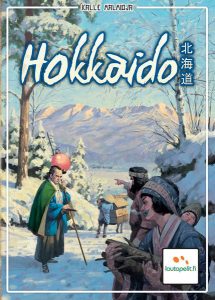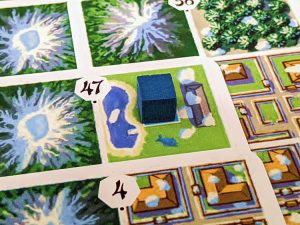 “After establishing themselves in Honshu, the Lords and Ladies head north to Hokkaido. Beholding Hokkaido’s mountainous landscape, they see that expansion on this land will prove to be a greater challenge than before.”
“After establishing themselves in Honshu, the Lords and Ladies head north to Hokkaido. Beholding Hokkaido’s mountainous landscape, they see that expansion on this land will prove to be a greater challenge than before.”
Hokkaido is the second entry to Renegade’s Nippon series and a successor to Honshu. In it, players compete to see who can build the highest-scoring map using cards printed with various terrain.
Gameplay Overview:
Hokkaido is a card drafting map building game for 2-5 players. Each player will begin the game with a hand of six cards, each of which contains six terrain squares. The object is to try and make large clumps of the same type of terrain next to each other. Different terrain types score in different ways.

For example, mountains are each worth two points and must be placed touching other mountains. As a result, your mountains will form a spine down the middle of your map – and you will score two points for each square in the smaller of your largest town on each side of the mountain range. Lakes are worth 3 points per square, but the first square doesn’t count making early planning crucial. There are also Deserts, Farms, Factories, and Forests, each of which has its own scoring rules.
Turns are simultaneous, with each player selecting a card from their hand and then adding it to their map. Cards are placed either over an existing card or under the map. Placement is simultaneous but if a player wants to wait to see what other players do, any player can declare that the turn should be resolved in turn sequence, said sequence being decided by the unique number printed on each card.
After card selection and placement, your hand is passed to the next player. When all six cards have been played, six more cards will be dealt to each player. When the second set of cards are played out, the game is over. Points are totaled and the player with the highest score is the winner.

Game Experience:
The Settlers of Honshu have pushed towards the mountains, and now snow speckles the countryside. Much like those settlers, players of Honshu are likely to find most of the landscape very familiar with a few interesting tweaks.
I never cared for the bidding in Honshu. Cards were selected, pooled, and the person who managed to get the best number got their choice of card. I’m never a fan of random turn order rules—its far too likely that one person will get a bad card draw and wind up eating the chaff most of the game. No one wants to play like that. City builders can rejoice now that Hokkaido has relegated that mechanic to a variation. You may still get stuck with bad cards, but now at least you won’t have to bid and get even worse ones.

The rulebook is well laid out and avoids the biggest pitfall of followup type games—it never relies on your knowledge of Honshu to explain the rules. Outside of a reference to drafting it doesn’t bring up the other version, which makes this perfect for folks new to the series. For experienced players, sections are well labeled, so you can skip around to reacquaint yourself with the rules quickly before launching into a game.
My only real issue is the same one I had with Honshu. I love to line up bits and cards—these, unfortunately, can never be as orderly as one might hope. Larger chunky borders make things just out of line (sort of like a crocked picture) and the card finish causes them to slip around as you move them, creating mini earthquake fault lines in your established areas. While I enjoy city building, I find it hard to get too proud of my finished creations because they’re just wonky enough to make your brain whimper.
I really appreciate the addition of the variant goal cards, which create objectives players can advance to and claim. The city building can get very one-note—almost kind of solo play outside of the bidding—but the goals get you refocused on what everyone else might be working towards as well as giving you a focus. The art has a nice upgrade as well, though the wooden cubes still get a little lost on the busy card fronts.
Final Thoughts:
Hokkaido isn’t different enough from Honshu to feel like the next in a series, but it does feel like a nice, somewhat upgraded replacement for it. Goals give your game more focus, and the bidding mechanic is relegated to a variant. Lovely art on the cards (front and back) makes this one feel more thematic. And if you’re new to either game no worries, Renegade has you covered with a full rulebook. I wouldn’t just buy Hokkaido over Honshu for a friend, I’d consider it as a replacement for my own.
Final Score: 4 Stars – Editing the Honshu rules just enough to make a better game experience, Hokkaido shows that you can improve on a winner with just a few tweaks.
 Hits:
Hits:
• Small box
• Thorough Rule book
• No more bidding
Misses:
• Cards still don’t line up
• A little visual business makes it hard to scan for pieces





















